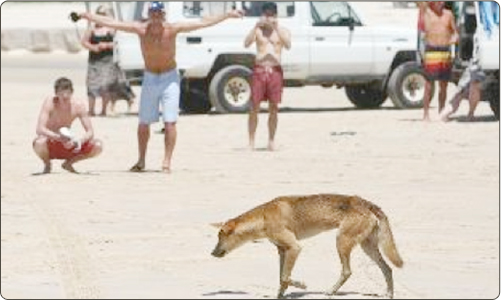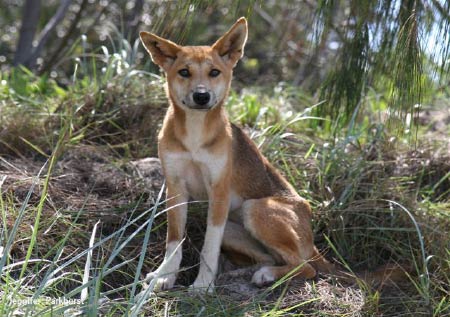
Dingoes have a long history of companionship and sharing food with humans, going back to Aboriginal times when they spent part of their time out freely hunting, and other times lay around camp sites. Under the Forestry management, dingoes were allowed to scavenge in food dumps, and campers were encouraged to leave their scraps out the back of their camp sites for the dingoes to ‘clean up’. Forestry workers even wormed them!

Dingoes know that humans are an easy way to get food, and you will often see a dingo watching fishermen, and waiting for free fish. Dingoes also occasionally tour through campsites and sit of the periphery of a camp, watching and waiting for an opportunity to be given some free food or to find some left over scraps. In most cases dingoes simply sit back beyond the light of the camp and watch. If a dingo chooses to sit near you feel very honoured and enjoy its company but do not try to approach the animal, and don’t try to lure it with food. Dingoes do not like to be patted so please never reach out you hand to pat them, especially over their head. This is seen by dingoes as predatorial behaviour and very threatening.
Dingoes are shameless thieves, and will take any opportunity to steal whatever they can from you. This is not because the item has your scent on it and they see it as a food item, it is because they love to play with whatever new and novel item they can find. Do not leave your thongs outside your tent, or leave anything out of your vehicle that you can’t afford to have stolen. This obviously includes food, but also includes sleeping mattresses, which they love to tear up into small pieces, and anything else you own including expensive camera equipment!
Part of dingo play behaviour is an activity called ambush or rushing. This is where the dingo suddenly rushes at a sibling, bowling him over, which instigates a play fight. Play fighting consists of mouthing, nipping and biting each other, as with all dogs. Dingoes unfortunately do not understand that our skin is not as strong as theirs and that we don’t have protective fur.
The most favourite game of the dingo is chasey. Therefore if you attempt to run away from the dingo it will immediately take chase. In doing so it will most probably nip or bite at your ankles. Likewise NEVER run into the water. Dingoes love water play and a person in water excites them.
If a dingo approaches you with play-type behaviour, do not respond. Stand still, look the dingo in the eye, and back away if you feel you need to. If a dingo follows while you are walking, turn to face the animal and walk backwards slowly until it gets bored and moves away. Do not over react or move suddenly, as this will excite the dingo into further play. Do not run towards the surf.
Dingoes are not aggressive by nature and do not attack people for no reason, so don’t be alarmed. They are however very gregarious, playful animals. Dingo play can look very aggressive but is in fact benign.
Dingoes hate being ‘told off’ and in my experience quite often sulk for hours afterwards. So a stern word is usually all it takes to send them scurrying away with their tails between their legs.
Correct behaviour results in calm dingoes that play amongst themselves.
The best reason for not feeding dingoes and not encouraging them is that if QPWS sees a particular dingo interacting with people on too many occasions, it becomes classified as a ‘problem animal’. Problem animals have reports made against them, and can eventually get destroyed. So for the sake of the dingoes on Fraser, enjoy seeing them in the wild, take as many photos as you like, but please don’t encourage them to come near you or your vehicle. And remember, any sightings of dingoes that you report to QPWS staff are written down and can be used against that animal in the future.
IN THE SEVEN YEARS I HAVE BEEN WORKING IN CLOSE PROXIMITY TO DINGOES ON Fraser Island I have NEVER been attacked or ever felt threatened by a dingo. if you follow the above advice neither will you.
Jennifer Parkhurst. Wildlife Photographer.
Please visit Jennifer’s website for more on the Fraser Island Dingo. CLICK HERE





